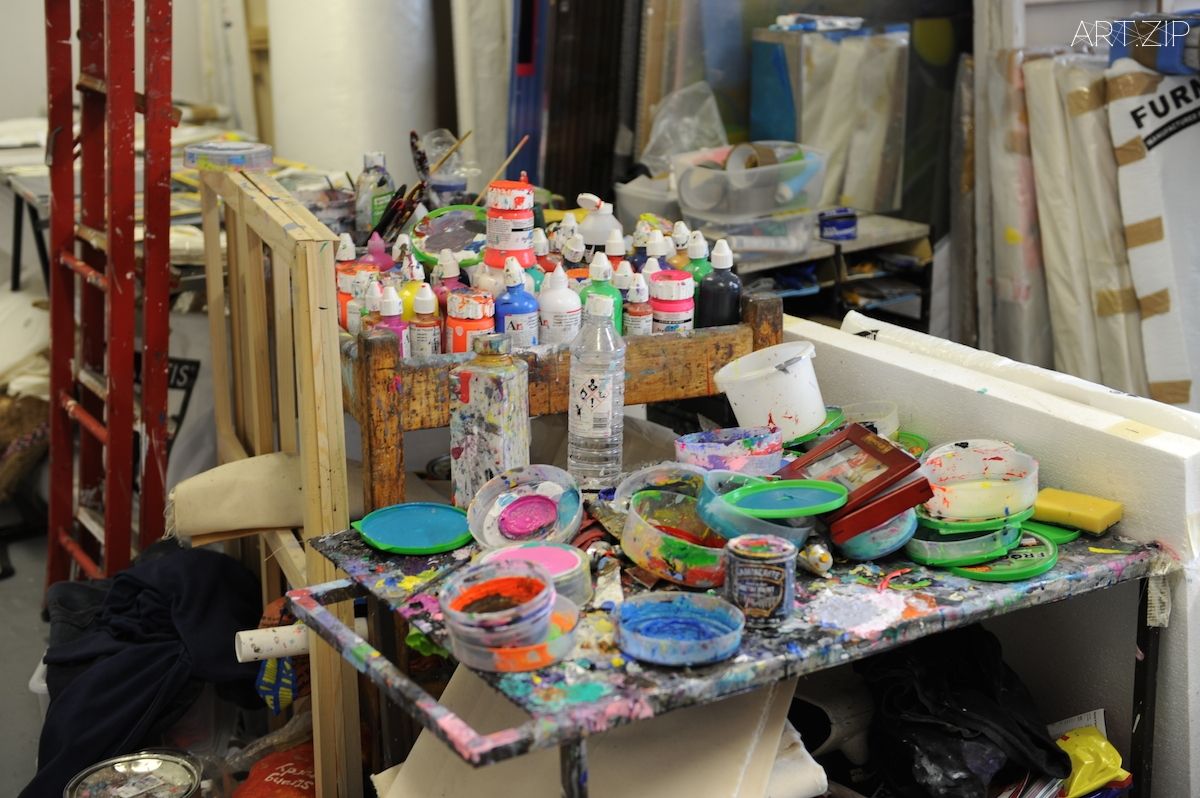
ART.ZIP: To develop the work and yourself.
ART.ZIP: 去發展作品以及你自己。
DR: That’s it. And you’re learning from you, which is interesting and then people reacting to it – the public. I’m always working with a viewer in mind and am always conscious when talking to students that art is a three way dialogue between the artist, the object and the viewer. If it is just the artist and the object then it is only therapy – you have to have this idea of the viewer – that doesn’t mean you make the painting for the viewer, or the object, or the experience but you acknowledge that there is probably going to be someone else looking at it at some point. So I always work with a viewer in mind, as opposed to, and I have seen it over the years, artists who are making work for a particular collector. You have got to make work for a viewer, who may become a collector. Who knows?
The studio can to some artists act like an emblem – and reflect perceived status. When we think about Dutch painting in the seventeenth century, say, painters like Rembrandt or Van Dyke, were painting self portraits as young men, displaying their artistic skills, but they also showed, embedded in their clothes and other finery, their status in the society around them. They were for hire and they were doing well!
DR: 沒錯。你從自我中學習,而公眾將對此做出反應。在創作的時候,我總在考慮觀眾,也總對學生們說,藝術是藝術家、作品與觀眾之間的三方對話。如果這個對話之中只有藝術家和作品,那這就只是藝術治療(用藝術為媒介來實行的一種輔助心理治療手段)。你必須要有觀眾的概念,這不意味著你必須為了觀眾、作品本身或某種藝術體驗而繪畫,但你必須意識到除了你自己还會有甚麼人在甚麼時候看到你的作品。所以我在創作中總在考慮觀眾,而不是像我在這些年來經常看到的一些藝術家一樣,只考慮某位特定的收藏家。創作不能脫離觀眾,誰知道哪位觀眾日後就成為收藏家了呢?
工作室對於某些藝術家來說是个象徵,象徵著他的地位、身份。在十七世紀荷蘭繪畫中,倫勃朗(Rembrandt)與凡·戴克(Van Dyke)等畫家經常通過繪製自畫像來展示自己的高超技藝,但他們同時也通過服飾和珠寶展示自己的富有以及社會地位。他們為了錢而畫,可是他們畫得也相當好啊!
–
ART.ZIP: In China there are less galleries and so artists need their space to make a statement because they are dealing the work themselves. Here it is quite different because galleries do the marketing and the promotion and the other stuff and so artists can focus on what they produce.
ART.ZIP: 中國沒有那麼大量的畫廊,所以自行進行作品交易的藝術家們需要一個體面的工作室來展示他們的作品。英國的狀況很不一樣,畫廊完成了大部分的推廣與市場活動,藝術家得以專心於創作。
DR: It is very interesting, because of the relative newness of the situation and the sheer scale of China. From an outside perspective you can see the possibilities being amazing, but also a massive problem. You can’t just adopt artistic expression, it’s an organic thing that comes from birth and is metered out over a period of time through doubt or failure. Wasn’t it Samuel Beckett who said “fail and fail better”.
Seen against a slightly existential European perspective, artists in China may believe that they have got this wonderful space, this wonderful situation and therefore must make wonderful things. That can be a real problem. Artists will crumble or make things according to prior expectation if it is not handled the right way. Of course there are great artists who go against that, like Ai Weiwei, or I could give lots of examples of artists with an independent voice and whether you agree with the politics or not is neither here nor there, but the independence of the artist is paramount. If an art dealer ever asked me, say, oh I like that one but can you do it bigger or in blue, then that’s the end of it – however much that would effect me economically – that is the end.
DR: 這一點很值得探討,尤其因為中國的藝術市場很大但又是相對新興發展起來的。從旁观者看来,中国市场有着很好的发展前景,但同時也存在着巨大的問題。你不能簡單地摹仿藝術表達形式,因為這些藝術表達形式從一開始就是一個個有機體,是經歷過漫長歷史的考驗的。貝柯特(Samuel Beckett )曾經說過:“失敗沒關係,下一次失敗得好看些。”
以一個存在主義式的歐洲視角來看,中國藝術家可能認為,因為他們擁有很好的工作室空間、很好的創作條件所以他們必須做出很好的東西來。這是一個大問題,如果不謹慎的話,藝術家將遇到挫折或創作出無趣的東西來。艾未未或其他一些獨立發聲的藝術家是一些很好的例子--而是否同意他們的政治觀點不是我們要在這裡討論的--藝術家的獨立性才是最重要的。如果一個藝術經銷商對我說,“我喜歡這件作品,但你能不能把它畫得再大點或者換成藍色?” 那就完蛋了,無論這將對我造成多大的經濟影響,我都不會妥協。
–
ART.ZIP: Does your time in studio make you feel isolated, or do you want to be isolated?
ART.ZIP: 每天花這麼長時間呆在工作室會不會覺得孤獨?還是說,您希望與別人保持距離?
DR: I never feel isolated. I always have music or the radio on. You can see I have lots of old vinyls , studio friends say I am stuck in the nineteen seventies and it is true!
I love the graphics as well, look at that Shalamar and Herbie Hancock LP. So there is seventies and eighties stuff around because I used to be a DJ when I was younger, for about eight years.
There are so many references and games going on in the work. I even think of some elements I use as coloured lenses. I am as much influenced by the graphic images on LPs as well as art historical figures such as de Kooning, Kandinsky, Larry Pitman or Laura Owens and also the sheer visual dexterity of someone like Chris Ofili who is a good friend. I don’t see myself as an abstract painter, interestingly these are paintings that happen to end up in a space that is termed that, but these are just paintings. The writer Martin Holman described it in a very simple way, but I think a very good way – stating that my paintings are representations of abstraction, perhaps that relates to what you were saying about Kandinsky – there is a sense of the familiar.
So I never feel isolated because there is this hum, whether it is the radio or music and I need that constant distraction so I don’t get into a regular pattern. I constantly want to see and reveal things to myself, like even this morning I just started with this with pen and then with watercolours and then a bit of collage. I never feel isolated because I have music and I have friends in the studio – so we go for a coffee or go for lunch – it’s sociable situation.
DR: 我從來不覺得孤单。我總在這裡聽唱片或電台。你可以看到我這兒有許多老唱片,隔壁工作室的藝術家總說我活在上个世紀70年代,我也這麼覺得!
我也非常喜歡唱片封面設計。我有很多70以及80年代的唱片,因為在年輕的時候我曾經做了8年DJ。唱片封面設計有許多對藝術的引用以及幽默的圖像遊戲。它們對我的創作來說就像是某種濾鏡一樣。這些唱片封面設計對我創作的影響並不亞於德·庫寧(de Kooning)、康定斯基(Kandinsky)、拉里·皮特曼(Larry Pitman)、勞拉·歐文斯(Laura Owens)或我的好友克里斯·奧菲利(Chris Ofili)對我的影響。我不覺得我是一個抽象畫畫家,儘管這些畫作經常被放置於這樣的一個討論之中去,這些只是繪畫而已。我比較贊同作家馬丁·霍爾曼(Martin Holman)對我的畫的描述,他說得很簡單,他說我的畫就是抽象的再現,也許這與康定斯基的影響有關,看著是有種似曾相識的感覺。
因為在工作室里我經常會聽電台或唱片,所以我從來不覺得孤獨。我需要有些事情轉移我的注意力,不然我很可能會陷入一個死板的創作模式中去。我想要自己不斷地去試驗來發掘新的東西。就像今天早上我先用這支筆畫了些草圖,然後再用水彩描繪,之後還有一些拼貼。我從不覺得孤單,我有音樂,還有隔壁工作室的朋友們,我們經常一起去喝咖啡或吃午餐,這裡是一個可以進行互相交流的地方。
Find Out More:
http://www.dannyrolph.com
http://www.barbaradavisgallery.com

